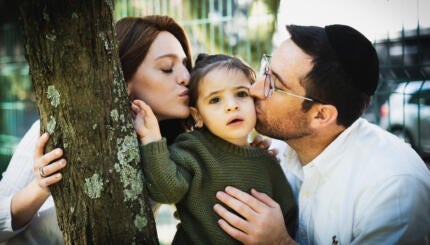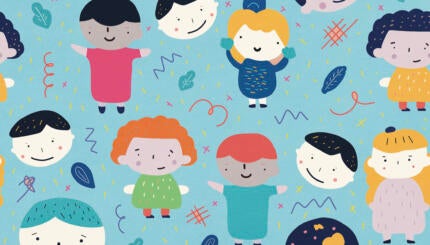History is full of bizarre twists and turns, and the fate of a language can be as unpredictable as the fate of a people. In 1945, the future of Yiddish looked bleak. Millions of its speakers had been murdered, and the audience for Yiddish literature was practically wiped out. Many survivors focused on learning Hebrew or English–the languages they needed to build new lives. Meanwhile, Yiddish fell by the wayside, becoming the language parents and grandparents spoke when they wanted to hide things from their children.
Klezmer is Suddenly Cool
But nearly 60 years later, klezmer music is suddenly cool. The melodies our grandparents laughed and cried to are played in places where twenty-somethings gather, from New Orleans jazz clubs to Montreal cafés. Meanwhile, recent American Jewish literature–like Nathan Englander’s For the Relief of Unbearable Urges–pays constant homage to Yiddish fiction masters like Sholom Aleichem, Y.L. Peretz, and I.B. Singer. For young writers like Englander, Yiddish humor amid tragedy is an inspiration. Many of these Yiddish stories, like Sholom Aleichem’s Tevye the Dairyman, are readily available in English, and sometimes, North American readers decide they want to check out the fiction in its original language.
The majority of current Yiddish speakers, of course, are from Hasidic and Haredi (ultra-Orthodox) families who raise their children with Yiddish as their mother tongue. These large families have led some scholars to believe there may be a million Yiddish speakers again. But the more surprising story is the slow but seemingly steady increase in Yiddish lovers in the non-Hasidic world.
“In the Jewish ‘mainstream’, interest in Yiddish may be growing,” says Neil Zagorin, bibliographer at The National Yiddish Book Center in Amherst, Mass. “It will probably not again be the vernacular or cultural language of the Jewish ‘masses’ the way it was before the Holocaust. Most ‘mainstream’ Jews will not be fluent or literate in Yiddish.”
With your help, My Jewish Learning can provide endless opportunities for learning, connection and discovery.
“What is significant is that a growing number of young Jews are reconsidering–or considering for the first time–the meaning of the Ashkenazic Jewish heritage as an important part of contemporary Jewish identity, alongside Jewish religion, ancient Jewish history, modern Israeli history, and so on,” Zagorin says.
Literature, Music, Art
This interest in Yiddish is evident at places like Makor, a cultural gathering place dedicated to New Yorkers in their 20s and 30s. Makor offers a range of Yiddish classes, along with the usual Hebrew and Judaism fare that’s at most JCCs.
Looking into Yiddish can mean much more than just language classes, says Zagorin. “It can mean young Jews who take courses in modern Jewish social history along with other coursework in Jewish studies. It can also mean interest in the literature written in Yiddish, whether they read it in Yiddish or translation.” Studying Yiddish can lead to an interest in the music, theater, and folk arts of Ashkenazic Jewry, Zagorin says.
There are signs of this interest all over the place. A small ad in New York’s Jewish Week this month promised cash stipends to people trying to live near other Yiddish speakers. Each summer, a slew of Yiddish festivals pop up in Canada and the U.S. And a growing number of universities offer academic credit or degrees in Yiddish. Well-known intensive language programs include those from The YIVO Institute for Jewish Research in New York and the University of Vilnius. In addition, the Oxford Center for Yiddish Studies, the University of Paris, and Bar-Ilan University have run intensive Yiddish programs.
A few dedicated American organizations–including YIVO, Workmen’s Circle, and The National Yiddish Book Center–host conferences, fund internships, and put out publications that help keep Yiddish alive in the English-speaking world. These events usually involve less of a time commitment, and attract people in their 20s and 30s.
Yiddish on the Web
The web is also helping to connect lovers of Yiddish with each other; the website www.derbay.org lists events around the world, including classes, conferences, and concerts. It has links to the Yiddish pen-pal organization, which has 300 members divided according to ability.
Meanwhile, Yugntruf – Yugnt far Yidish, the site of Youth for Yiddish, is aimed at people in their 20s, 30s, and 40s who are into Yiddish. The calendar listing includes groups like the Yiddish Writers Circle. YIVO just started a summer program alumni newsletter, available online, which should help connect its 1,200 alumni.
For those enrolled in university, cool Yiddish-related internships abound. The National Yiddish Book Center offers graduate students a chance to work on preserving Jewish books while taking Yiddish classes. Each year, the Center receives about 40 applications for an average of 8 slots, depending on funding. “The students learn Yiddish half the day and help shelve books the other half a day,” says the center’s director of education Rabbi Phil Graubart.
In the summer, the Center also hosts a College Creativity Workshop that brings students interested in creative writing and film together. This year, there will be a four-day workshop with prominent Jewish writers including Alicia Ostriker and Irena Klepfisz, along with agents and publishers.
This kind of innovative programming is helping to keep Yiddish and institutions concerned with Yiddish on the map. Yiddish is becoming a part of a new generation’s cultural life, affecting its music, its literature, and even its tastes in humor. Yiddish may never regain its foothold in Europe, but it may have found a loving, remodeled home in North America.
Reprinted with permission from The Avi Chai Bookshelf, where Birthright Israel alumni can order free books and magazines.
Hasidic
Pronounced: khah-SID-ik, Origin: Hebrew, a stream within ultra-Orthodox Judaism that grew out of an 18th-century mystical revival movement.


